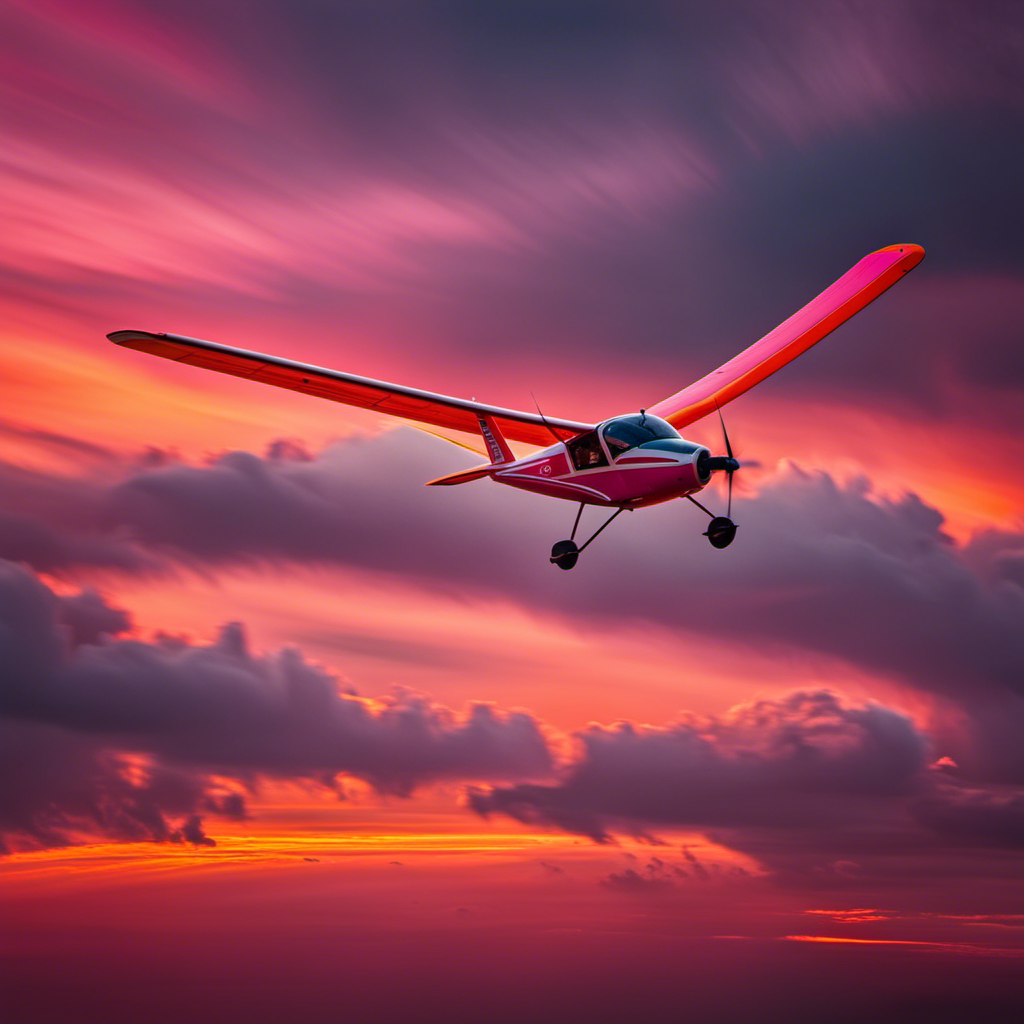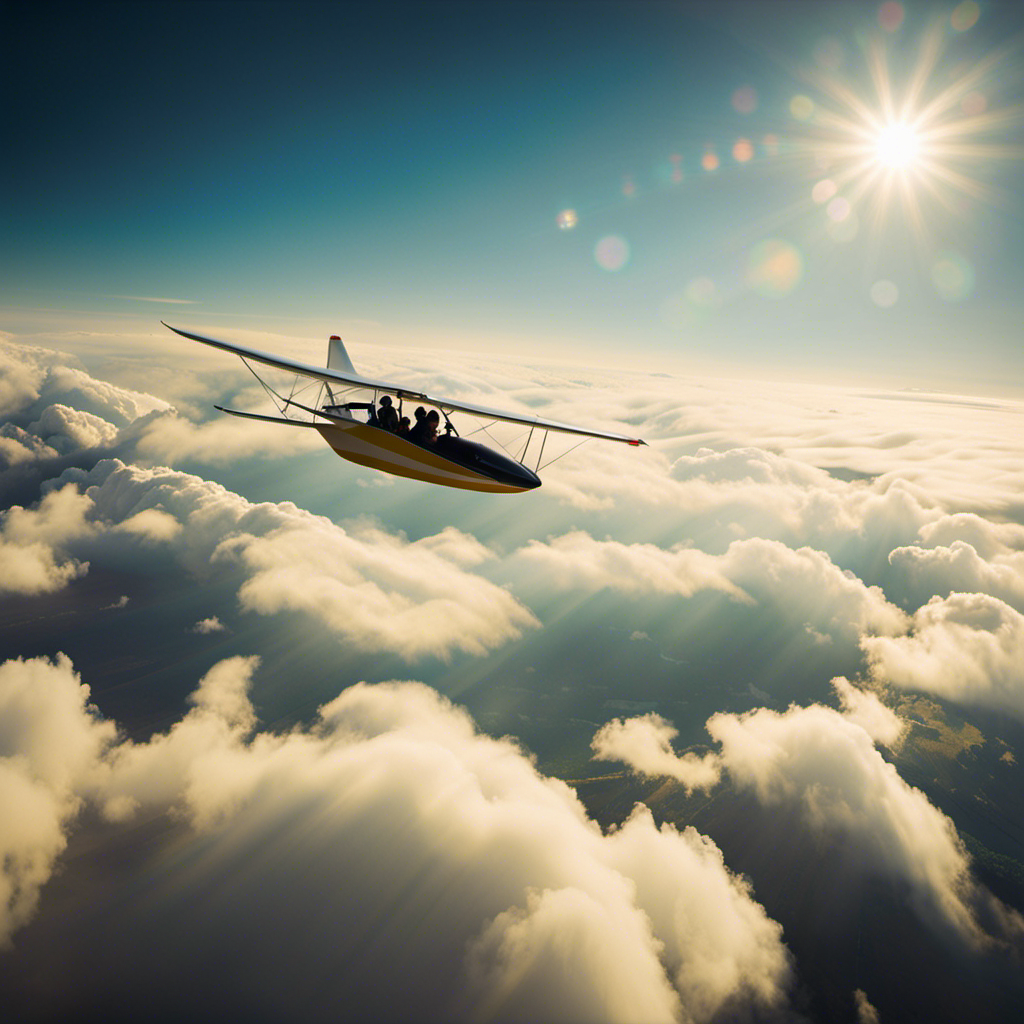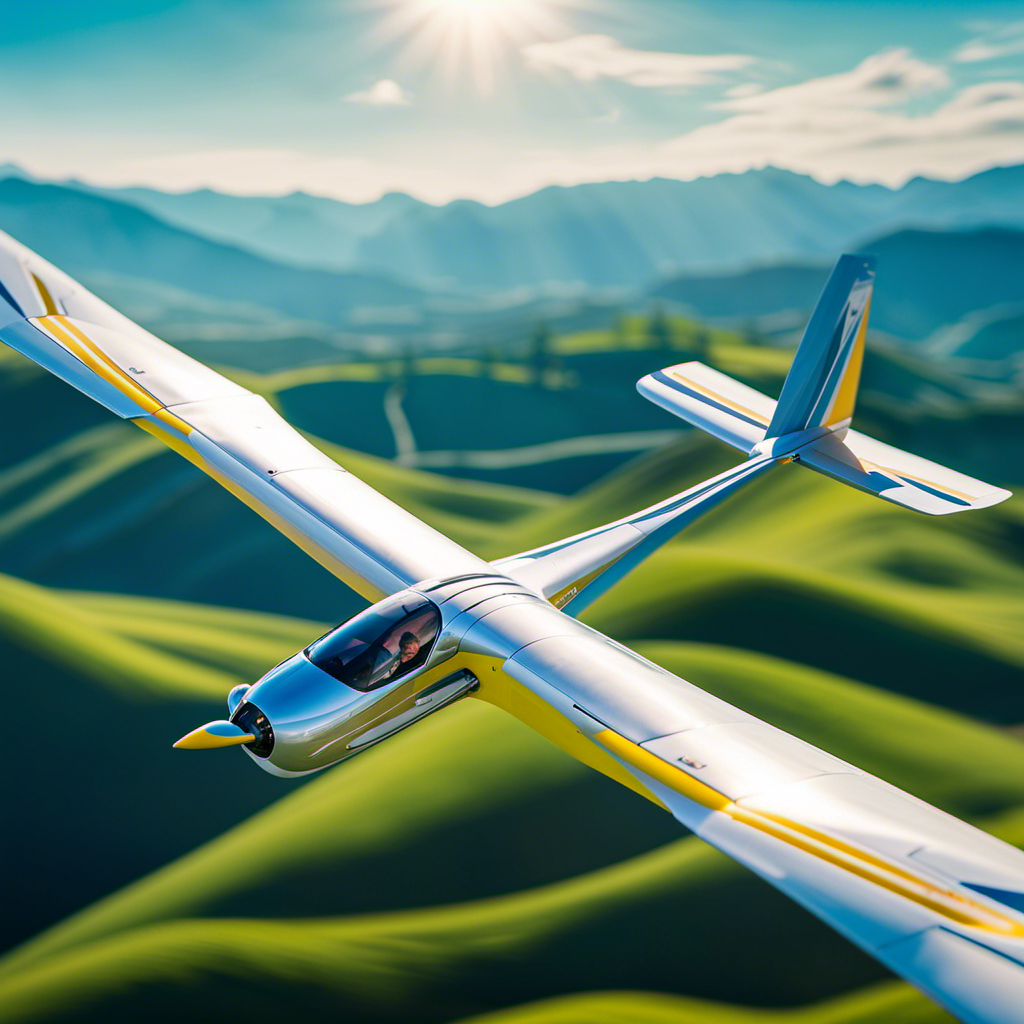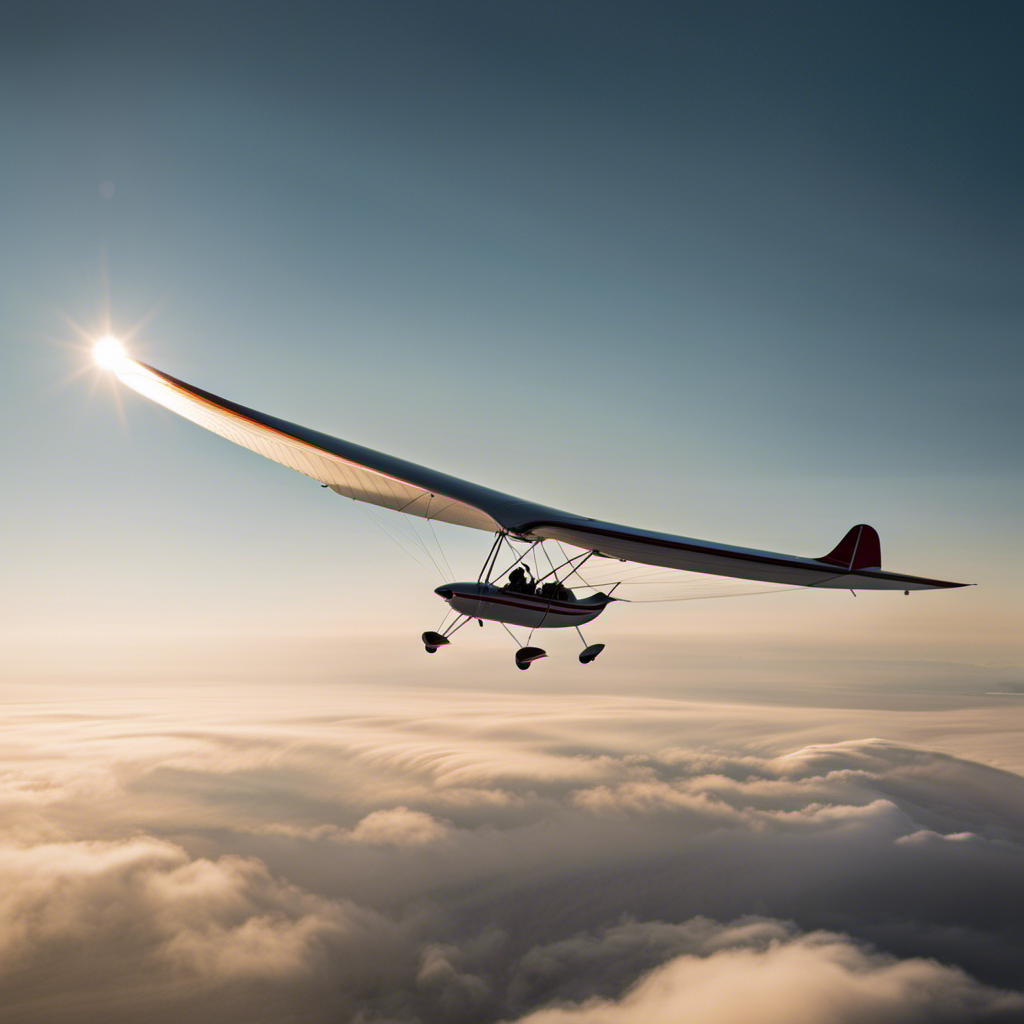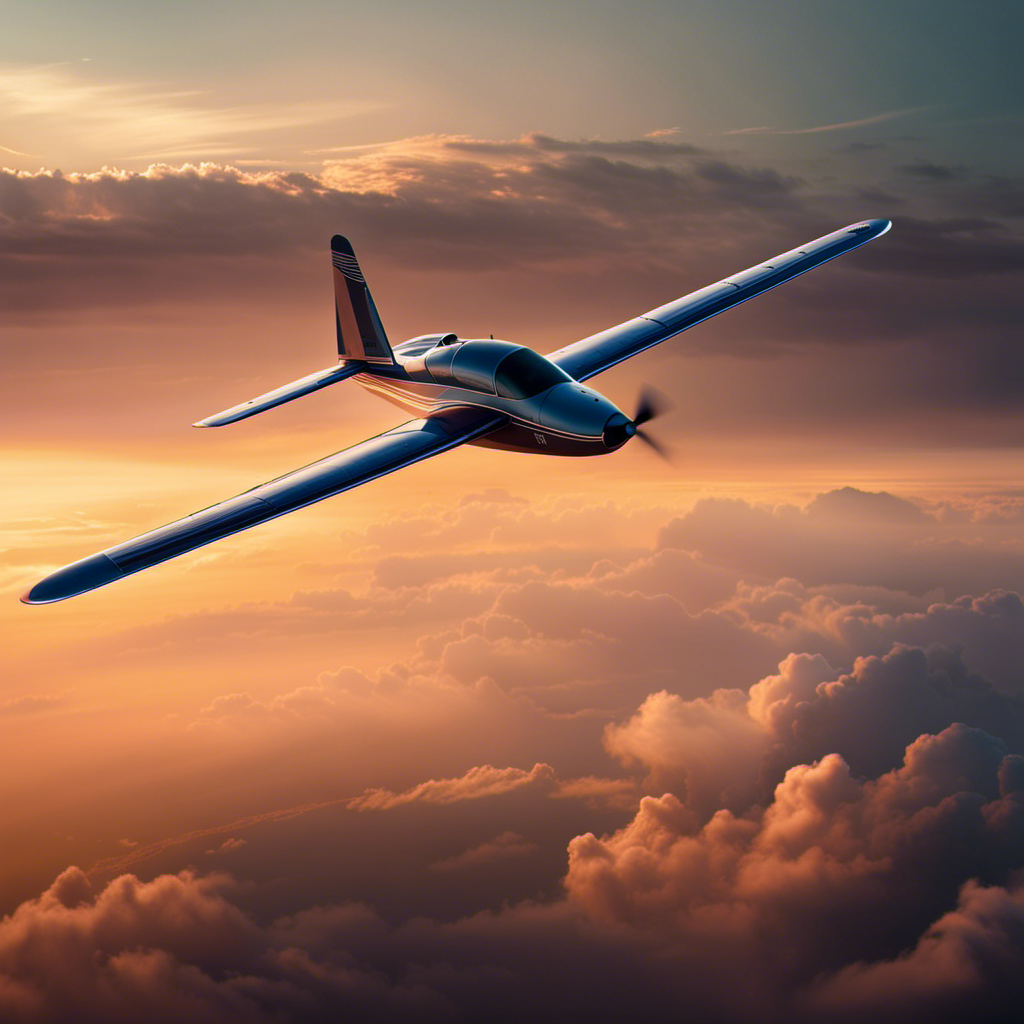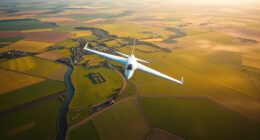As an individual who flies gliders, I can confidently state that gliding through the air in a glider is both exhilarating and deeply inspirational. Picture yourself soaring through the sky, feeling the rush of the wind on your face as you effortlessly drift among the clouds.
Contrary to popular belief, flying a glider is not scary, but rather a thrilling adventure that allows you to disconnect from the noise of the world and connect with the pure joy of flight.
In this article, I will provide insights into the safety measures, unique experiences, and potential challenges of glider flying, helping you overcome any fear or anxiety you may have.
Key Takeaways
- Overcoming fear and anxiety through trust in training and guidance
- Glider flying provides a sense of freedom, tranquility, and peace
- Testimonials from experienced pilots highlight the benefits and joys of glider flying
- Tips and advice for first-time flyers to ensure a safe and enjoyable experience
What is a Glider?
A glider is a type of aircraft that doesn’t have an engine. It relies on the forces of nature, such as gravity and air currents, to stay aloft. Gliders are made up of various components, including a fuselage, wings, and a tail.
The fuselage is the main body of the glider, where the pilot sits and controls the aircraft. The wings provide lift, while the tail helps with stability and maneuverability.
To fly a glider, proper training is essential. This includes learning about the different controls, understanding aerodynamics, and practicing takeoffs and landings. Glider training also involves studying weather patterns and learning how to read the sky for optimal flying conditions.
By gaining knowledge and experience in glider training, pilots can enjoy the thrill of flying without an engine.
Now, let’s explore the safety measures in glider flying.
Safety Measures in Glider Flying
Remember to always follow the safety measures while operating a glider. Glider safety should be your top priority to ensure a smooth and enjoyable flight.
Before takeoff, there are several important pre-flight preparations to consider. Firstly, thoroughly inspect the glider, checking for any signs of damage or wear. Pay close attention to the wings, control surfaces, and landing gear. Additionally, ensure that all necessary safety equipment, such as parachutes and harnesses, are in good condition and properly secured.
Familiarize yourself with the glider’s emergency procedures and practice them regularly. Finally, always check the weather conditions and avoid flying in unfavorable or dangerous weather.
The Experience of Flying in a Glider
Immerse yourself in the sheer exhilaration of soaring through the sky in a glider, feeling the wind on your face and the freedom in your heart.
Gliding is a unique and awe-inspiring experience that allows you to connect with the elements and witness the world from a whole new perspective.
As a seasoned glider pilot, I can assure you that the flying techniques used in glider flying are both challenging and rewarding. The absence of an engine means relying solely on thermals, updrafts, and air currents to stay aloft.
But the effort is worth it when you witness the breathtaking views from high above, with mountains, lakes, and sprawling landscapes stretching out before you.
Now, let’s explore the differences between glider flying and powered flight, and how they each offer their own unique thrills.
Differences Between Glider Flying and Powered Flight
Contrasting glider flying and powered flight, the main difference lies in the reliance on thermals and updrafts for gliding versus the use of an engine for powered flight. In glider flying, pilots must learn to read the sky and understand the subtle changes in air currents to stay aloft and gain altitude. This requires mastering the art of using thermals, updrafts, and ridge lift to keep the glider airborne. On the other hand, powered flight relies on the use of an engine to generate thrust and maintain altitude. This fundamental difference in flying techniques also translates into differences in training requirements. While powered flight pilots must acquire the necessary knowledge and skills to operate an aircraft with an engine, glider pilots must focus more on understanding meteorology and the dynamics of air currents.
| Glider Flying | Powered Flight |
|---|---|
| Relies on thermals and updrafts for lift | Uses an engine for lift |
| Requires understanding of meteorology and air currents | Focuses more on aircraft control and navigation |
| Training emphasizes reading the sky | Training emphasizes engine operation and maintenance |
Understanding these differences is crucial for aspiring pilots to choose the right path and pursue the appropriate training for their aviation goals. Now, let’s delve into the potential challenges and risks that come with flying gliders and powered aircraft.
Potential Challenges and Risks
One of the potential challenges and risks associated with flying gliders and powered aircraft is the unpredictable nature of weather conditions. As an experienced pilot, I understand the potential dangers that can arise when weather conditions change unexpectedly. Strong winds, turbulence, and sudden storms can pose a significant threat to the safety of a flight.
To mitigate these risks, it is essential to take safety precautions such as thoroughly checking weather forecasts before each flight, utilizing advanced weather radar systems, and maintaining constant communication with air traffic control. Additionally, pilots should undergo regular training to enhance their skills in handling adverse weather conditions. By being knowledgeable and prepared, pilots can minimize the potential dangers and ensure a safe flight.
Now, let’s explore the benefits of glider flying.
Benefits of Glider Flying
As an experienced glider pilot, I can confidently say that glider flying offers several key benefits.
One of these benefits is the lower cost compared to powered flight. Gliders do not require expensive fuel and engine maintenance, making them a more affordable option for those who want to take to the skies.
Additionally, glider flying is environmentally friendly and sustainable, as it relies solely on the natural forces of wind and thermals for propulsion. This makes it a greener alternative to powered flight, contributing to a cleaner and more sustainable aviation industry.
Lower Cost Compared to Powered Flight
Flying a glider is much more affordable than flying a powered aircraft. As a glider pilot, I can attest to the affordability advantages and accessibility benefits of this type of aviation.
Here are three reasons why glider flying is a cost-effective choice:
-
No fuel costs: Gliders don’t require fuel, which eliminates the ongoing expense of refueling. This makes each flight significantly cheaper compared to powered aircraft.
-
Lower maintenance costs: Gliders have simpler mechanical systems and fewer components compared to powered aircraft. This results in reduced maintenance and repair expenses.
-
Affordable training: Learning to fly a glider is often more accessible than obtaining a powered aircraft license. The training costs are generally lower, making it a more budget-friendly option for aspiring pilots.
Environmental Friendliness and Sustainability
Choosing to pilot a glider is a greener and more sustainable option due to its reduced carbon emissions. Gliders are powered by renewable energy sources such as wind and thermals, minimizing the environmental impact of flying. Unlike powered aircraft that rely on fossil fuels, gliders harness the power of nature, making them an eco-friendly choice for aviation enthusiasts. By utilizing the natural elements, glider flying significantly reduces the carbon footprint associated with traditional aviation. The table below highlights some of the key aspects of renewable energy in glider flying and its impact on the carbon footprint.
| Renewable Energy in Glider Flying | Impact on Carbon Footprint |
|---|---|
| Harnessing Wind and Thermals | Reduces Emissions |
| Zero Fuel Consumption | Minimizes Pollution |
| Sustainable Aviation Option | Promotes Environmentalism |
Overcoming Fear and Anxiety
Don’t worry, you’ll quickly overcome any fear or anxiety once you experience the freedom and tranquility of gliding through the sky.
As an experienced glider pilot, I can assure you that managing anxiety is a normal part of the learning process. The key to overcoming fear is to trust in the training and guidance provided by skilled instructors. They will teach you the necessary skills to handle any situation, ensuring your safety at all times.
Additionally, practicing deep breathing techniques and visualization exercises can help calm your nerves before taking flight. The more you fly, the more comfortable and confident you will become.
So, embrace the challenge, push past your fears, and enjoy the incredible sensation of soaring through the air.
Now, let’s hear some remarkable testimonials and experiences from glider pilots who have conquered their fears and embraced the thrill of flying.
Testimonials and Experiences from Glider Pilots
Having flown in gliders for many years, I’ve accumulated a wealth of personal stories and insights that can be invaluable to first-time flyers. From breathtaking sunsets to unexpected turbulence, I’ve experienced it all and can offer tips and advice to help ease any fears or concerns.
I can provide tips on choosing the right clothing for comfort and understanding the basics of glider flight. I’m here to provide the knowledge and expertise needed for an enjoyable first-time flying experience.
Personal Stories and Insights
I’ve always loved hearing personal stories and insights about flying gliders. It’s fascinating to listen to pilots talk about overcoming their initial fears and how the experience has brought them countless benefits and joys.
One pilot shared how they conquered their fear of heights by stepping into the cockpit and pushing their boundaries. Another pilot described the indescribable feeling of freedom as they soared through the sky, detached from the noise and chaos of the world below.
These stories inspire and motivate those who are considering taking to the skies in a glider. If you’re a first-time flyer, there are some important tips and advice to keep in mind to ensure a safe and memorable experience.
Tips and Advice for First-Time Flyers
If you’re a first-time flyer, there are some important tips and advice to keep in mind for a safe and memorable experience. As someone who has been flying gliders for years, I can offer some valuable insights.
First and foremost, always listen to your instructor and follow their instructions. They are there to ensure your safety and guide you through the flight.
Additionally, make sure to dress appropriately for the weather and wear comfortable shoes. It’s also crucial to understand the safety precautions, such as fastening your seatbelt properly and familiarizing yourself with the emergency procedures.
Lastly, stay calm and trust in the expertise of your pilot. With these tips for beginners and safety precautions in mind, you’ll be well-prepared for your upcoming glider flight adventure.
Now, let’s move on to preparing for your glider flight.
Preparing for a Glider Flight
To prepare for your glider flight, make sure to review the safety procedures and familiarize yourself with the equipment. Before taking off, it is crucial to go through a pre-flight checklist to ensure that everything is in order. This includes inspecting the glider for any damage or loose parts, checking the control surfaces and instruments, and verifying that the emergency equipment is readily accessible.
Additionally, understanding the basics of aerodynamics is essential for a safe and enjoyable flight. This knowledge will help you comprehend how the glider stays aloft and how to control its movements. By knowing the principles of lift, drag, and weight, you will have a better understanding of how to maneuver the glider through the air.
So, with a thorough pre-flight checklist and a grasp of aerodynamics, you will be well-prepared for your glider flight.
Now, let’s move on to the conclusion: should you try glider flying?
Conclusion: Should You Try Glider Flying?
After weighing the pros and cons of glider flying, I can confidently say that it is an exhilarating and rewarding experience. The freedom of soaring through the skies without an engine is unmatched, and the feeling of being one with the elements is truly remarkable.
In my final thoughts, I encourage anyone who has even a slight interest in aviation to give glider flying a try. It may just be the start of a lifelong passion.
Weighing the Pros and Cons
Flying a glider has its advantages and disadvantages. As someone who has spent countless hours soaring through the skies, I can confidently say that the pros outweigh the cons.
Glider flying offers an unparalleled sense of freedom and exhilaration. The feeling of soaring through the air without an engine is truly unmatched.
However, it’s important to acknowledge that fear and anxiety can be a barrier for some. Fortunately, with proper training and experience, these fears can be overcome. Learning the intricacies of glider flying and gaining confidence in your abilities are crucial steps in conquering any anxieties.
It’s also worth noting that the glider community is incredibly supportive, and fellow pilots are always there to lend a helping hand and share their own experiences.
Final Thoughts and Encouragement to Give it a Try
If you’re looking for a thrilling and liberating experience, glider flying might just be the perfect activity for you. As someone who has conquered my fear and experienced personal growth through glider flying, I can assure you that it is an exhilarating and transformative journey.
Here are some reasons why you should give it a try:
-
Overcoming Fear:
-
Glider flying allows you to confront your fear of heights and flying, helping you build resilience and confidence.
-
The controlled environment and experienced instructors provide a safe space for you to face and conquer your fears.
-
Personal Growth:
-
Glider flying pushes you out of your comfort zone, encouraging personal growth and self-discovery.
-
It teaches you to trust yourself, make quick decisions, and adapt to changing situations, fostering personal development.
-
Thrilling Experience:
-
Gliding through the air with no engine noise is an unparalleled sensation of freedom and excitement.
-
The breathtaking views from the glider provide a unique perspective, leaving you in awe of the beauty of the world.
Frequently Asked Questions
How much does it cost to fly a glider?
Flying a glider can be an exhilarating experience. Glider flying expenses include a cost breakdown that typically includes membership fees, rental fees, and instruction fees. However, the cost varies depending on location and specific glider club.
Can anyone fly a glider, regardless of their physical fitness level?
Regardless of your physical fitness level, anyone can fly a glider. It’s a thrilling experience that doesn’t require intense physical exertion. Strap in, take control, and soar through the skies with ease.
Are there any age restrictions for flying a glider?
There are no age restrictions for flying a glider. However, safety measures must be followed to ensure a safe flight. It is important to receive proper training and adhere to all regulations.
How long does it take to learn how to fly a glider?
Learning to fly a glider requires dedication and time. The learning curve can vary, but with consistent training and practice, you can become proficient in a few months. It’s an exhilarating and rewarding journey.
Are there any opportunities for solo flying in glider flying?
Yes, there are opportunities for solo flying in glider flying. Solo flying offers numerous benefits, including building confidence and enhancing skills. However, it is important to consider safety measures and undergo proper training before venturing into solo flights.
Conclusion
In conclusion, glider flying is an exhilarating and awe-inspiring experience that should not be missed. It may seem daunting at first, but with proper training and safety measures in place, the risks are minimal.
Flying in a glider is like soaring through the sky on the wings of a bird, feeling the wind beneath your wings and the freedom of the open air. It is a truly unique and unforgettable experience that will leave you with a sense of awe and wonder.
So, don’t let fear hold you back, take the leap and try glider flying for yourself. You won’t regret it.
